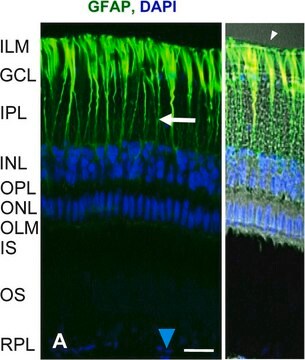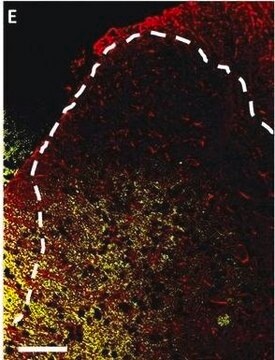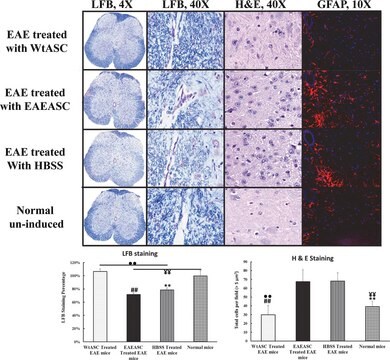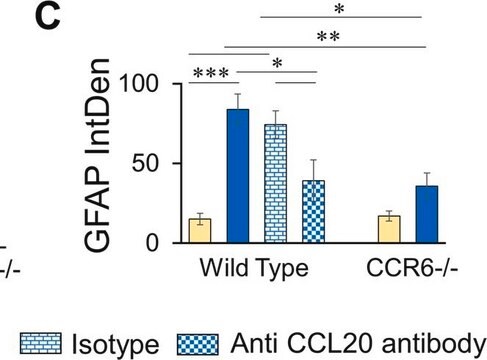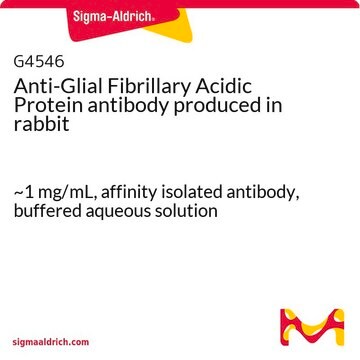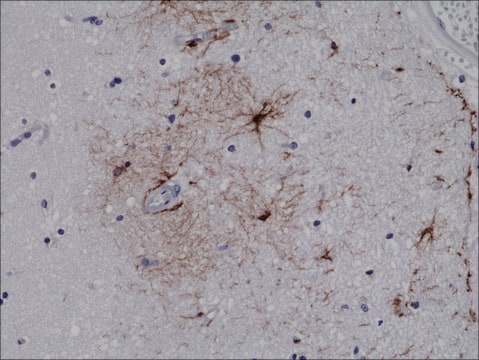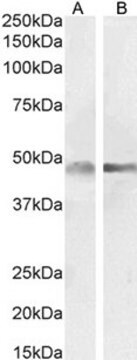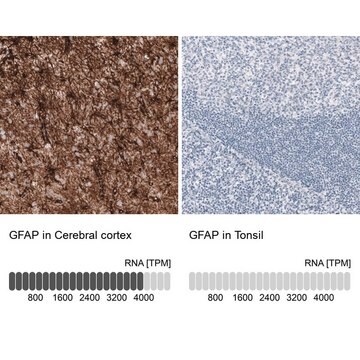추천 제품
제품명
Anti-Glial Fibrillary Acidic Protein antibody produced in rabbit, IgG fraction of antiserum, buffered aqueous solution
생물학적 소스
rabbit
Quality Level
결합
unconjugated
항체 형태
IgG fraction of antiserum
항체 생산 유형
primary antibodies
클론
polyclonal
양식
buffered aqueous solution
종 반응성
rat, human
포장
antibody small pack of 25 μL
기술
immunohistochemistry (formalin-fixed, paraffin-embedded sections): 1:80 using brain sections
microarray: suitable
western blot: 1:500 using brain extract
UniProt 수납 번호
배송 상태
dry ice
저장 온도
−20°C
타겟 번역 후 변형
unmodified
유전자 정보
human ... GFAP(2670)
rat ... Gfap(24387)
일반 설명
The GFAP (glial fibrillary acidic protein) gene encodes an intermediate protein filament-III (50kDa). It is localized particularly to the astrocytes and non-myelinating Schwann cells of the central and peripheral nervous system, respectively.
특이성
The product reacts specifically with GFAP and labels astrocytes, glial cells and glial cell derived tumors in immunohistochemical staining. The antibody reacts with glial specific antigen in alcohol or formalin-fixed, paraffin-embedded human or animal tissue sections.
면역원
GFAP from human brain
애플리케이션
Anti-Glial Fibrillary Acidic Protein antibody produced in rabbit is suitable for:
- immunohistochemical staining at a working dilution of 1:400 using rat brain sections
- immunohistochemical staining of human brain tumor tissue specimens to identify the cells expressing AQP4 (Aquaporin-4)
- immunofluorescence using brain section from mice
생화학적/생리학적 작용
Glial fibrillary acidic protein may be used as a marker for distinguishing astrocytes from other glial cells during development of the central nervous system. GFAP is responsible for maintaining the structure of glial cells. It also offers mechanical strength and support to the surrounding neurons and blood brain barrier. Defects in this gene causes Alexander disease, indicated by Rosenthal fibers deposition. It is a rare disorder of astrocytes in the central nervous system. Increased GFAP expression indicates astrogliosis, a sign of neurodegeneration and neuroinflammation.
물리적 형태
Solution in 0.01 M phosphate buffered saline, pH 7.4, containing 15 mM sodium azide
저장 및 안정성
Store at 2-8 °C up to one month. For extended storage, solution may be frozen in working aliquots. Repeated freezing and thawing, or storage in "frost-free" freezers, is not recommended. If slight turbidity occurs upon prolonged storage, clarify by centrifugation before use.
면책조항
Unless otherwise stated in our catalog or other company documentation accompanying the product(s), our products are intended for research use only and are not to be used for any other purpose, which includes but is not limited to, unauthorized commercial uses, in vitro diagnostic uses, ex vivo or in vivo therapeutic uses or any type of consumption or application to humans or animals.
적합한 제품을 찾을 수 없으신가요?
당사의 제품 선택기 도구.을(를) 시도해 보세요.
Storage Class Code
12 - Non Combustible Liquids
WGK
WGK 2
Flash Point (°F)
Not applicable
Flash Point (°C)
Not applicable
가장 최신 버전 중 하나를 선택하세요:
이미 열람한 고객
Alberto Serrano-Pozo et al.
Brain : a journal of neurology, 133(Pt 5), 1312-1327 (2010-04-03)
Anti-amyloid-beta immunization leads to amyloid clearance in patients with Alzheimer's disease, but the effect of vaccination on amyloid-beta-induced neuronal pathology has not been quantitatively examined. The objectives of this study were to address the effects of anti-amyloid-beta active immunization on
Glial fibrillary acidic protein: from intermediate filament assembly and gliosis to neurobiomarker
Yang Z and Wang K K
Trends in Neurosciences, 38(6), 364-374 (2015)
Induction of glial fibrillary acidic protein expression in astrocytes by nitric oxide
Brahmachari S, et al.
The Journal of Neuroscience, 26(18), 4930-4939 (2006)
S Saadoun et al.
Journal of neurology, neurosurgery, and psychiatry, 72(2), 262-265 (2002-01-18)
Aquaporin-4 (AQP4) is a highly conserved water channel protein. In rats, AQP4 is expressed in astrocyte foot processes and is important in brain water homeostasis. AQP4 expression has not been investigated in non-neoplastic human brain or oedematous brain tumours, where
Dana M Niedowicz et al.
Acta neuropathologica communications, 2, 64-64 (2014-06-12)
Mid-life obesity and type 2 diabetes mellitus (T2DM) confer a modest, increased risk for Alzheimer's disease (AD), though the underlying mechanisms are unknown. We have created a novel mouse model that recapitulates features of T2DM and AD by crossing morbidly
자사의 과학자팀은 생명 과학, 재료 과학, 화학 합성, 크로마토그래피, 분석 및 기타 많은 영역을 포함한 모든 과학 분야에 경험이 있습니다..
고객지원팀으로 연락바랍니다.

